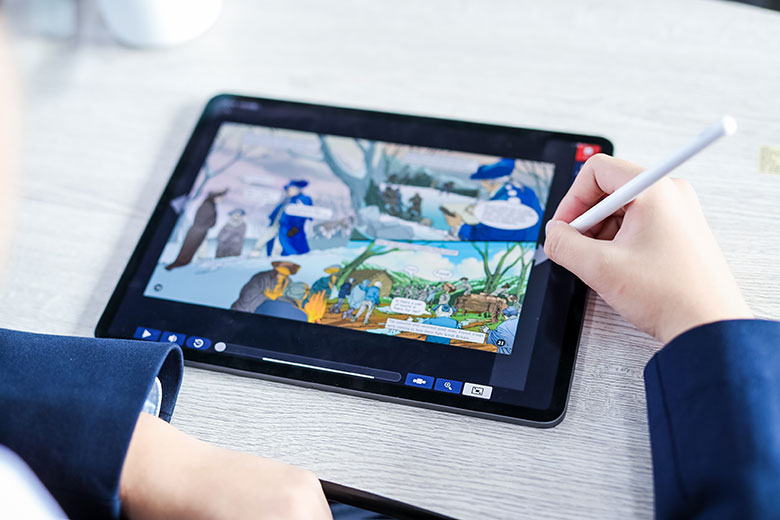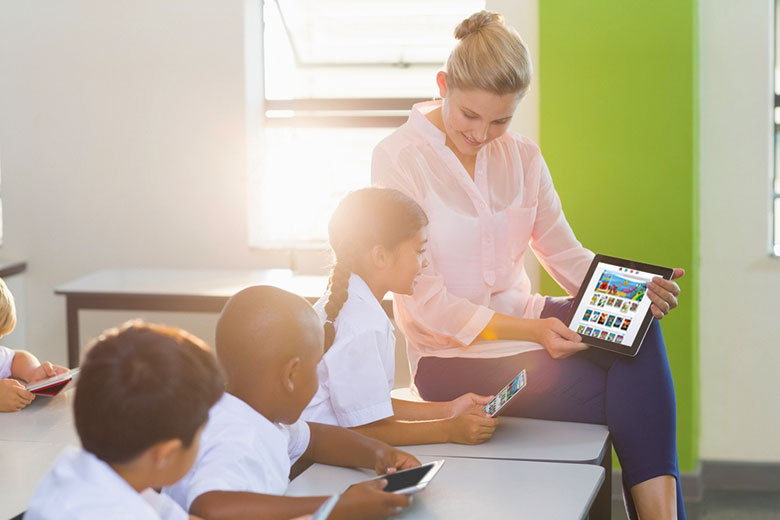Blended learning, a hybrid model that integrates the best aspects of both traditional classroom teaching and online learning platforms, offers several benefits. Perhaps most importantly, promoting student engagement and active learning by incorporating technology and interactive elements into the educational experience. Of course, in a rapidly evolving world, not everyone is yet fully on board, so we took the opportunity to speak with Joan Mill, Group Managing Director, International at Renaissance, which today helps teachers, schools, and ministries of education accelerate learning in more than 100 countries across six continents, first asking her about the ‘fear factor’ in EdTech.
“There is perhaps a fear or reluctance by schools and some ministries of education to utilise blended learning fully,” Joan begins, “but I do think this trepidation is beginning to evaporate. In many ways, the pandemic has accelerated the adoption of technology and software, not least because it challenged the way teaching and learning should be delivered and catapulted the world into a new way of thinking, whilst not compromising the quality of lessons.”

“We are really empathetic to the profession, constantly looking to see how we can help enhance the skills that the professionals already have in order to get them to help their students even more”
Joan, who joined Renaissance in early 2022 – having held senior executive roles in both the FinTech and LegalTech sectors – is big on tech enablement to drive even more efficiency. One of the many reasons she joined Renaissance was the fact that the company has been operating in the cloud for more than 25 years, creating numerous innovative online and adaptive solutions for the education industry. Recently, though, EdTech has moved forwards in leaps and bounds, with Joan explaining: “Many people will point to the pandemic as a catalyst for increased technology in education, and this is true to a degree. However, in spite of that and in some parts of the globe, blended learning environments were becoming the norm, as when implemented effectively, they can genuinely enhance the learning experience. This has been a steadily growing view.
“As a result, at Renaissance, we’ve been working really hard to ensure that those who have been slightly more hesitant to climb aboard, can see the benefits of this approach to drive increased support for children with their learning, while also helping to keep parents engaged.”
“One of the big phrases we use is student engagement”

While change naturally introduces the unknown, we believe that the revolution of education through increased Technology, can enhance the experience for students and teachers. This is why Renaissance looks to teachers as our ‘north star’ and places them at the centre of everything we do. “We are really empathetic to the profession, constantly looking to see how we can help enhance the skills that the professionals already have in order for them to help their students even more,” Joan says. “We have a number of ex-teachers and academics working at Renaissance which helps give us a genuine understanding of the many challenges educators face, but more importantly, the solutions they would like to see.”
Technology offers interactive learning experiences through multimedia elements such as videos, animations, simulations, and quizzes. These interactive tools can engage students’ interest, make complex concepts more understandable, and promote active participation in the learning process, thus enhancing student engagement in the classroom.
“I’m very passionate about efficacy of implementation,” Joan says, “and how using technology helps students, teachers, or indeed governments, increase literacy and numeracy. That’s something we’ve been very big on at Renaissance. In fact, using our vast data set, we have conducted our own studies with countries and government departments, to evidence how student attainment has been improved. Additionally, we have produced a report that focused on learning loss during the pandemic, which is now being used by the Bahamas Ministry of Education to drive rescue initiatives. Learning Loss has been a big topic over the past 2 years in order to understand the attainment gap and how long it will take to fill.
There is no doubt that technology empowers students to take ownership of their learning. With access to digital tools and resources, students can actively explore and pursue their interests, engage in self-directed learning, and showcase their creativity and skills. This sense of ownership can contribute to students’ enjoyment and satisfaction with their educational experience, as Joan explains: “Students love it because they are now, very used to the omnipresence of technology. One of the main phrases we use is ‘student engagement’ – technology really helps because youngsters already use Kindles or iPads or tablets; they move through apps much more quickly than most, so if you can serve up education in a fun way that is easily digested while getting the pupil to a successful end result, why wouldn’t you do that?” “For instance, we have a literacy tool called myON that enables the teacher to get a number of students to take a very short test to see what their reading capability is, but, more importantly, we can ask students which topics they are actually interested in – and they’ll say sci-fi or nature for example – and what myON does is suggest books at the individual student’s ability level on that subject, which automatically makes the learning experience fun and engaging.”

Using Analytics and Insights to Drive Student Success
One of the major concerns teachers have today is their enormous workload. “It’s a big, big issue,” Joan says, “so if there is a way to help them to accelerate marking and, for instance, identify students who may require a little more help, it is critical that we do this. Overall, technology supports assessment in the classroom by clarifying a student’s capability, streamlining the learning process, providing real-time feedback, enhancing engagement and driving personalised learning. It empowers educators to make data-informed decisions, tailor instruction, and better support student growth and achievement.”
There have been numerous studies conducted to explore the benefits of technology in the classroom for both students and teachers, with a number based on the data provided by Renaissance. “That’s one of the reasons why I think we are really well placed when it comes to helping teachers in schools and ministries identify learning gaps: we have a huge data lake, which we have been enriching over decades and it really helps us to pinpoint where the challenges are, and that allows educators to make key decisions quickly,” Joan says.
As mentioned above, learning loss is an area of great focus. In the past two years, teachers have almost doubled their workload to help in closing the gap,” Joan explains. “And of course, there is also teacher well-being, with some teachers quite frankly needing a little support, emotionally and mentally as there is so much pressure placed on them, including the added burden of assessment.
“Teachers have so many challenges, with one of the biggest, because of the pandemic, being a huge loss of learning”
By leveraging technology, parents can have more timely and convenient access to information about their child’s education, fostering better communication, involvement, and collaboration between home and school. It helps parents stay informed about their child’s progress, address any concerns promptly, and actively participate in their child’s educational journey. “When using a computer adaptive way of learning, parents can easily engage in what their kids are doing. As information is served up on a tablet, for example, the youngster is really excited to show their parents what they have achieved and say, “Hey, I just took this quiz on this book I just read and look what I did!”. The parents can see it instantly – they don’t have to make an appointment or go down to the school, it’s instant. This helps with the school to home engagement,” Joan says
Whether it’s utilised by schools, teachers, or students, technology is a constantly evolving and dynamic field. New advancements, innovations, and trends emerge regularly, making it a moving target. So how does Renaissance stay up-to-date with everything that is going on? You may be expecting a bit of a ‘whizz kid’ answer here, but you’re not going to get one because this rather distinctive company primarily uses one of humankind’s most basic emotions to stay informed – passion.
“We are really passionate about two things, education and technology for ALL, and it’s in our DNA. For Renaissance therefore, it’s about making sure that we’re abreast of all of the new and wonderful technologies that are coming out and seeing how can we use some of them to enhance what we already have.”
“Although technology alone cannot replace effective teaching, it serves as a powerful tool that enhances and transforms the learning experience. Embracing it in schools helps prepare students for the future, fosters 21stcentury skills, and creates dynamic and engaging learning environments that better meet the needs of learners in the digital age. It ultimately helps teachers to level the playing field and ‘See Every Student’” Joan concludes.

Joan Mill, International Managing Director, has a wealth of Technology/SaaS and GTM experience. During the course of her career, she has focused on delivering innovative and transformative cloud and digital solutions for customers globally. She is dedicated to building high-performing teams and effective go-to-market strategies.
















